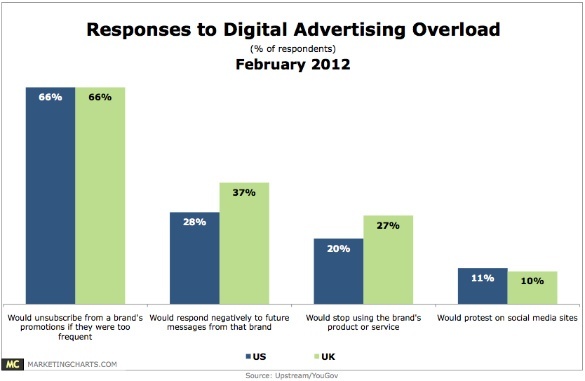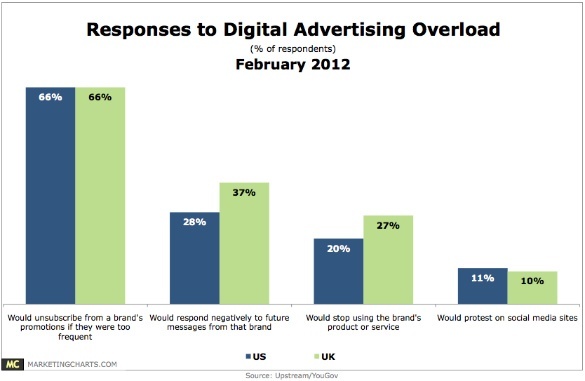
Research: Ad Overload Taking Toll
February 28, 2012 by Dave Haynes
It’s no real revelation when research confirms what’s been evident for years – people think they are bombarded with advertising. But it’s instructive to get real data on what gets under their skin and how they respond.
It’s also fascinating to see the device that scares the crap out of many Digital OOH ad people – the smartphone – is the device people hate seeing ads on the most.
Two-thirds of adults in the US and UK say they receive too many digital marketing promotions and are exposed to too many ads, according to a new survey by Upstream, as developed by YouGov.
“Consumers are not generally averse to being marketed to, but the past decade of ever-increasing volumes across all available channels is finally taking its toll,” says Marco Veremis, the president of the UK-based marketing technology firm. “Mobile is the next frontier in advertisers’ sights, driven by the promise of long-anticipated developments in handset technology and marketing opportunities in apps, such those rumoured for Facebook. However, marketers need to be especially mindful that the mobile will always be a deeply personal medium and to avoid a backlash, any advertising must be personal, intimate and targeted. Companies must avoid repeating the mistakes of the one-to-many broadcast and volume driven online advertising years and especially on mobile, they should focus on using short, text-based ad formats instead of intrusive graphical banners.”
Marketers beware: consumers will not be shy to act. Two-thirds say they would unsubscribe from a brand’s promotions if they thought the messages they were receiving were too frequent, while 27% in the UK and 20% in the US say they would stop using the brand’s product or service. 37% of UK respondents (and 28% of US adults) would respond negatively to future messages from that brand, and about 1 in 10 would protest on social media sites.
In general, 55% of the US consumers do not want to be targeted more than once a month, while the 18-24-year-old set are most tolerant of targeting as often as weekly or more (31%).
When asked which device they would like to receive ads and promotions on, respondents (UK and US combined) cited PCs first (39%), followed by laptops (24%). Just 4% said their smartphones, and only 2% indicated tablets. Indeed, two-thirds the consumers say they are turned off by unwanted advertising on their mobile or smartphone.
Data from the “2012 Digital Advertising Attitudes Report” indicates that 34% of consumers prefer to receive ads and promotions via a detailed email, more than double the proportion who prefer a short text-only message such as a tweet, Facebook message, Google Adwords message, or SMS (15%). These are the same top 2 channels consumers recently cited for receiving updates from brands, though with a much narrower gap: according to survey results released in December 2011 by AYTM Market Research, short updates from Facebook and Twitter (32%) and emails (27%) ranked as the leading ways in which consumers most prefer to get updates from their favorite brands.
Meanwhile, only a small proportion of the Upstream survey respondents say they respond positively to QR codes (9%) and augmented reality (2%).
Some marketing messages have a higher likelihood of getting through to consumers than others. 26% of the UK and US consumers say they are more likely to respond to messages tailored to their personal interests, while 22% are more likely to respond to promotions that are location-specific, and 21% to promotions that are contextually relevant to what they were doing. Other types of promotions that respondents report being more likely to respond to include those specific to the time they are sent (14%) and those with attention-grabbing phrasing (7%).
The research found only 11% of UK respondents and 15% of US consumers who have browsed the internet on their mobile phone have ever clicked on a mobile banner ad. Furthermore, just 1% of UK adults and 2% of US adults who browse on their devices click on banner ads frequently. 79% of UK respondents and 72% of US consumers find banner ads on their mobiles or smartphones to be irritating.
The Digital Advertising Attitudes Report 2012 was commissioned by Upstream and conducted by YouGov. The total sample size was 2,054 UK adults and 2,015 US adults. Fieldwork was undertaken from January 24-26, 2012, and the survey was carried out online.
I’m not entirely sure what the lesson is here for Digital OOH marketers, except to be respectful of their viewers and the context of the advertising. Mobile is a deeply personal device and some Digital OOH environments are deeply personal. I can imagine there are are any number of “not right now” things for medical network operators, for example.




nice post ! i just wish the guys at groupon could see this 🙂
I think the lesson is in the allure of mulit-channel engagement. It’s no secret that DOOH cannot work by itself, that it’s best utilized as a multi-channel approach. But, like most other things we humans ingest, moderation is key.
(Of course, I need to remember that for the Preset mixer…)